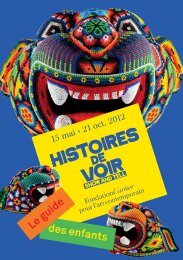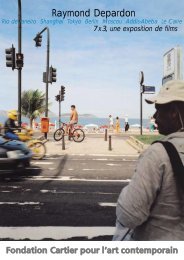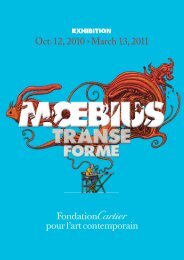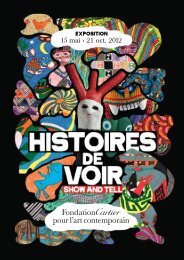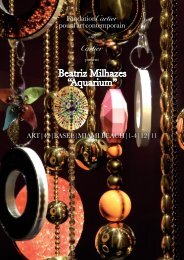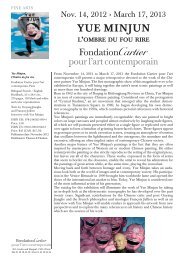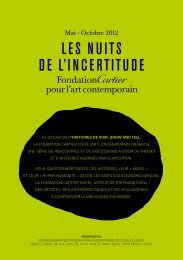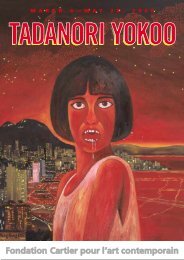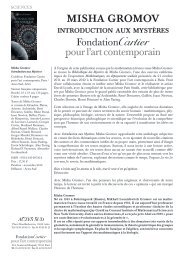DAIDO VERS PDF ANG - Fondation Cartier pour l'art contemporain ...
DAIDO VERS PDF ANG - Fondation Cartier pour l'art contemporain ...
DAIDO VERS PDF ANG - Fondation Cartier pour l'art contemporain ...
You also want an ePaper? Increase the reach of your titles
YUMPU automatically turns print PDFs into web optimized ePapers that Google loves.
Shinjuku, Tokyo, 2001 (series Shinjuku)<br />
Courtesy Daido Moriyama and Taka Ishii Gallery<br />
of photographs that reflect the disjunctive nature of<br />
contemporary urban experience. In this book, photographs<br />
of the eccentric characters of Terayama’s<br />
stage (a hairy-chested man dressed up as a geisha)<br />
are juxtaposed with strange and extraordinary<br />
images of daily life (a happy Japanese gathering of<br />
Lion’s Club members in their ritual American costumes).<br />
As Moriyama stated: “My underlying<br />
thought was to show how in the most common and<br />
everyday, in the world of most normal people, in<br />
their most normal existence, there is something dramatic,<br />
remarkable, fictional. This kind of chaotic<br />
everyday existence is what I think Japan is all about.”<br />
Moriyama was fascinated by the strange, the unusual,<br />
the extraordinary. As a result of this interest,<br />
he began to identify himself with those living outside<br />
of social norms. A great admirer of Jack<br />
Kerouac’s On the Road, Moriyama developed a photographic<br />
style that reflected the outsider’s point of<br />
view like the authors rambling voice in the novel. He<br />
began to shoot pictures whenever the mood struck<br />
him, while running or riding in a moving car. Grainy,<br />
blurred and askew, the resultant images suggest<br />
that they were made in haste, as in a secret gesture.<br />
Rather than carefully selecting and framing his<br />
images, he shoots freely without looking through<br />
the viewfinder, using his body more than his eyes.<br />
Describing his photographic method, Moriyama has<br />
stated: “I turn to the right and photograph a poster,<br />
then, I turn around and photograph the street.<br />
Sometimes I even turn the camera on myself. I do so<br />
without discrimination and without any internal<br />
contradiction.”<br />
Moriyama’s Accidents series, published in Aishi<br />
Camera in 1969, expands upon Warhol’s own series<br />
of the same name. In this series, Moriyama appropriated<br />
images taken from television screens, news-<br />
papers and police safety posters. Like Warhol,<br />
Moriyama acknowledges a world in which everything<br />
has become a representation.<br />
Ultimately, the originality of Moriyama’s photographs<br />
lies in their ambiguous relationship to reality.<br />
Throughout his career, Moriyama constantly wrestled<br />
with the quandary of expression in a presumably<br />
transparent medium and ultimately concluded<br />
that photography is unable to convey a fixed meaning.<br />
His book, entitled Farewell Photography, published<br />
in 1972, expresses this dilemma. Bleached,<br />
scratched, dirtied by dust, its pictures are pushed to<br />
a point of illegibility in an attempt to photograph the<br />
void itself. There are images of nothingness: a closeup<br />
of a dirty street, a blank wall, a reflection in a<br />
blank television screen. This book questions the very<br />
nature of representation, expressing a nihilistic<br />
doubt in our capacity to ever fully grasp reality<br />
through its photographic representation. The artist<br />
suggests that there is no one natural reality available<br />
to express our beliefs and sensations. For Moriyama,<br />
perhaps the only true reality to be found is in the act<br />
of photography itself.<br />
Stray Dog, Misawa, Aomori, 1971<br />
Daiwa Radiator Factory Collection<br />
Cover page:<br />
High Heel, Nakano, Tokyo, 1985<br />
and Rose, Shibuya, Tokyo, 1984<br />
(diptych, series Lettre à Saint-Lou)<br />
Courtesy Daido Moriyama and Taka Ishii Gallery<br />
A catalogue (160 pages, bilingual English/French)<br />
will be published on the occasion of the Daido<br />
Moriyama exhibition.<br />
Press information<br />
Linda Chenit assisted by Nathalie Desvaux<br />
tel. 33 (0)1 42 18 56 77/65 fax 33 (0)1 42 18 56 52<br />
email lchenit@fondation.cartier.fr<br />
online images/fondation.cartier.fr<br />
261, boulevard Raspail 75014 Paris<br />
tél. 33 (0)1 42 18 56 50 fax 33 (0)1 42 18 56 52<br />
fondation.cartier.fr<br />
The Daido Moriyama exhibition is organized with the support<br />
of the <strong>Fondation</strong> <strong>Cartier</strong> <strong>pour</strong> l’art <strong>contemporain</strong> under the aegis of<br />
the <strong>Fondation</strong> de France, and with the sponsorship of <strong>Cartier</strong>.




